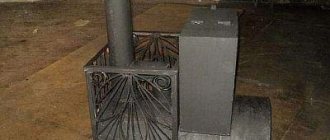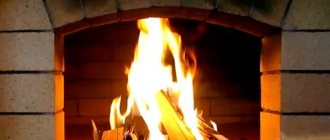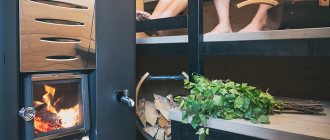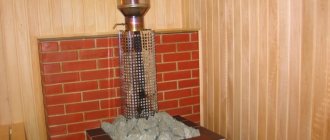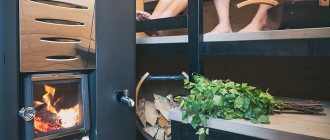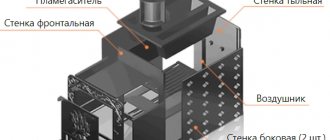Buildings of any type with a steam room require a heating structure capable of heating the air to high temperatures. However, purchasing a finished product entails considerable financial expenses, so individual developers very often make sauna stoves from iron with their own hands. It is metal that is a good conductor between the combustion chamber and the environment.
The photo shows a homemade iron structure.
Initial information
Self-made structures made of steel, when compared with their brick counterparts, are distinguished by the speed of construction and increased heat transfer. To carry out the work, it is enough to find a pipe whose diameter will be approximately 50 centimeters. Such products are especially relevant for small objects.
Requirements
Approximately the following pipe needs to be prepared.
- The heating structure must be located in a place where reliable fire protection is provided for materials subject to easy ignition.
- The area occupied by this object should not exceed 0.15 percent of the useful square footage of the heated room, since it is not very comfortable to carry out water procedures in a cramped environment.
- The side surfaces of the structure must be covered with heat-insulating materials so that the risk of burns is minimized.
- When installing, you should take care of the correct location of the stove, because the heat emanating from it should spread in different directions, thereby ensuring high-quality heating.
Basic elements
When making an iron stove for a bathhouse with your own hands, every novice craftsman must familiarize himself with the main components that make up the structure.
Any of the fragments listed below performs some function, so it is important to study all the details in full.
The structure of a sauna stove with water supply.
- The firebox is the main chamber where organic fuel is usually burned to heat the walls and then the surrounding air.
- The ash pit is located below the previous chamber, ensuring the collection of ash, which is formed as a result of the combustion of organic substances.
- The stone container allows you to lay cobblestones of jadeite, gabbro-diabase, crimson quartzite or other high-temperature resistant analogues.
- The pipe is a hollow product that is necessary to remove combustion products from the main chamber.
- The grate is an element inside the firebox that makes it possible to hold a layer of solid substance intended to produce thermal energy.
- Blower and firebox doors allow you to control the flame by covering it, which leads to a decrease or increase in oxygen inside.
- A pipe valve is usually made in the form of a control element that moves perpendicular to the working medium.
Shown is a homemade grate made from rebar.
Attention! If the building combines a washing compartment and a steam room, then the hot water tank is installed directly on the stove. However, in such a bathhouse it is also possible to have stands above the stones.
Recommendations
The fuel material must be completely burned, and to achieve this goal, an optimal amount of oxygen must be supplied. Therefore, the total area of the distance between the grates is no more than 60% of the total area of the grate. If the distance is smaller, a small air flow will enter the stove; this will not be enough to maintain the combustion process in the combustion chamber.
If the distance between the grates is large, the fuel material will fall without having time to burn out. This will lead to an increase in combustion consumables.
The cast iron grate for the stove provides good traction and is used for burning wood, coal and fuel briquettes. Cast iron still occupies a leading position in the manufacture of grates. Since it is least susceptible to deformation at high temperatures.
What is a grate for?
This important element of the furnace combustion chamber allows you to get the maximum effect from fuel combustion. The structure of modern stoves is constantly being modified and improved, and only the main structural element of the firebox remains unchanged. The combustion equipment retains its grate configuration.
The platform supports any type of solid fuel (firewood, coal and briquettes). Through the through openings, air is sucked in from below, which creates effective draft inside the combustion chamber. Combustion products (ash) fall into the ash pan (ash pan), freeing up space for the top layer of fuel. The grate promotes uniform combustion of fuel, thereby achieving maximum thermal energy transfer from the fuel placed in the combustion chamber.
Grill installation
To make a grate for a boiler, a fixed beam structure is most often chosen. This is a composite model, based on a square or rectangle of four beams.
This square must be made according to the size of the combustion chamber in which the grate will be used. Small beams are welded into its base, and the distance between them must also be taken into account. It should be such that the material does not fall during the combustion process, and the burned residues can easily leak through these holes.
Types of grate
The grate is made from elements of different shapes, but only from cast iron and steel. Other materials do not withstand frequent calcination or are too expensive. Depending on the design, grate bars are divided into several types:
- tile grating;
- beam grate
- basket;
- mobile grid.
Tile grate
One of the most common types of grate is the tiled grate. The main feature of this design is the observance of strictly fixed dimensions. This grille is designed for an installation site of a certain size. A mandatory condition must be met - the presence of a gap between the outer perimeter of the grate and the walls of the firebox of at least 5 mm. If this size is not maintained, the cast iron grate may expand greatly when heated and damage the firebox.
Beam grate
The grate consists of a set of individual grate elements. On opposite sides of the installation site, grooves are made into which cast iron bars are placed. Such a system is not entirely convenient for cleaning grates, and today these designs are practically not found. However, it should be noted that when using an antique stove, this is an acceptable option for installing a grate.
Basket
The basket is the same lattice, only with high sides. This type of grate was used in open fireboxes, but now such equipment is practically not used
Mobile grid
The movable system allows you to avoid manual control of the grate. Automated long-burning furnaces are equipped with designs of this type.
Grate - grate
Grill installation
Metal tends to expand at high temperatures, so the grate must be installed with a small gap of no more than 5 millimeters in each direction.
The ledge in the combustion hole needs to be cut off; the grate itself will be located on it in the future. In a brick stove, the location for the grate is generally chosen below the opening of the firebox door by one brick. This must be taken into account to ensure that burning wood and coals do not fall on the floor.
At the installation stage, you should not install the grates tightly, since when heated the material is capable of deformation. This can lead to product failure and cracks in the oven itself.
It is also necessary to take into account that if triangular rods are installed in the grate, then it must be laid with triangles down.
How to choose a grate and install it yourself
The choice of grate depends on several reasons:
- Type of fuel;
- size of the firebox opening;
- furnace operating mode.
For example, if the stove is heated with wood, then the size of the firebox opening is 350×260 mm, the operating mode is year-round. The most suitable option would be a factory-made grate with a rectangular configuration with sides of 300 and 252 mm, made of cast iron. It will be very easy to install the grate with your own hands.
Buying tips
For high-quality combustion, not only the size of the grate is important, but also the weight of the fuel that it can withstand in one laying. The rods should not deform or wear out.
The grate must have a sufficient number of holes - at least 40% of the area of the part itself. If this figure is lower, then there will not be enough oxygen to maintain the fire, and the ash will remain on the grate and clog the stove.
If the gaps in the grate have a large area, then the remaining fuel will fall from the combustion chamber into the ash pan. Fuel consumption will become uneconomical.
Optimal lattice option
How to make grate bars with your own hands
The grates that are permanently installed in the furnace eventually burn out and become unusable. If the opening for the grate was made individually, then you can only install a grate of a certain size. A simple way to make a grate with your own hands is to weld a grate frame from a steel angle. To do this you need to prepare tools and materials.
Tool
List of required tools:
- welding machine;
- angle machine;
- sander;
- drill;
- vice;
- hammer;
- tape measure and ruler;
- square;
- pencil.
Materials
- corner 40×40×2840 mm;
- steel strip 100×40 mm.
Price policy
A quality product cannot have a low price. High-quality cast iron parts that will last for many years are expensive. And vice versa, light and cheap ones, made from a mixture of unknown materials, will quickly become unusable.
Approximate prices for furnace grates:
| Size | Price |
| 800x200 mm | 1200-1600 rub. |
| 915x250 mm | 1100-3000 rub. |
| 260x540 mm | 400-500 rub. |
It is better to buy these products in specialized stores. They provide a wide selection of models with different materials and price categories. Consultants will help you make the right choice based on your preferences, the nature of the fuel, and the frequency of operation of the heating device.
Step-by-step instructions for making a grate
Before you make grate bars with your own hands, you need to clarify the initial data. The firebox opening subframe is made from a 50×50 mm corner with an internal perimeter of 265×335 mm. Therefore, the grate frame should be made with dimensions of 260x330 mm along the outer perimeter. Having prepared tools and materials, the following work is carried out:
- Using a corner machine, a corner 1180 mm long is cut.
- The side of the corner 40x40 mm is successively marked with a pencil into segments: 260, 330, 260 and 330 mm.
- Perpendicular lines are drawn in marking areas. From the top point, lay 20 mm in both directions. The sides of the equilateral triangle will be the cut lines.
- Using a corner machine, triangular fragments of the corner are cut out.
- Alternately clamping the steel workpiece in a vice, bend it into a frame with a hammer.
- The sides of the folds are connected by welding. The right angles of the frame are checked with a square.
- The remaining section of the corner is divided by a corner machine into 5 sections, each 322 mm long.
- The corners are welded into the frame with the feathers facing outward with 10 mm gaps between them.
- A grinder is used to remove all burrs and metal deposits after welding.
- A piece of strip is welded to one of the sides of the frame, having previously made a hole ø 6 mm in it with a drill. This is done so that when cleaning the grate it can be easily removed from the subframe.
- The finished grate is lowered into the subframe.
It is necessary to comply with safety regulations during work on assembling the grate. The master must have special clothing and shoes, especially for welding work.
The proposed manufacturing method is not suitable for everyone. You must have skills in handling welding equipment and power tools. As a last resort, a grate of this design can be ordered at any mechanic shop. It won't cost much, and the order will be completed quickly.
You can go another way. Instead of corners, cast iron grates 330 mm long are placed in the frame. To do this, appropriate grooves are made under the beam elements in the vertical corner of the frame. Despite the fact that the grate may initially seem difficult to implement, making it with your own hands is not difficult.
Author: geras, February 15, 2011 in General
Operating principle of the furnace
We keep the house warm according to the weather; it is convenient to heat the stove in the evening for 2-3 hours. Each stack of firewood - 3-5 logs 33 cm long is limited by the dimensions of the firebox in plan - 38x38 cm. With each firebox we burn 12-17 logs, per season 4 cubic meters, taking into account the bathhouse and waste incinerator.
The main part of the heat is accumulated in the hood, which allows you to dry wet towels and wet clothes around the clock. The reversible sleeve allows you to warm your back and quickly relieve fatigue. The stove works as follows: combustion products (smoke) make 4 turns:
The pattern of movement (turns) of smoke is marked with numbers in circles.
1st turn - at an angle of 90 degrees from the firebox to the hood; 2nd turn - in the hood the smoke is divided into two streams and each goes around an angle of 180 degrees along the arc of the hood; 3rd - at an angle of 90 degrees - the right flow of smoke from the hood enters the reversible sleeve (short path), and the left flow, having passed under the hood (long path), also ends up in the reversible sleeve; 4th - at an angle of 90 degrees from the transfer sleeve into the pipe.
The movement of smoke in each element of the stove is different, and this is especially evident in the reversible sleeve, in its chimney, which in area (25x25 cm) is twice the size of the previous chimney of the hood. Once in the transfer hose, the smoke “rests” there - its pressure, speed, temperature drop and it is in no hurry to enter the pipe - to make the last turn.
Therefore, there is a springboard in the reversible sleeve, but that’s not all. The stable draft of the pipe is created by its heated base and the walls of the chimney. When finishing heating the pipe, leave hot coals at its base and close the door of the mini-fireplace. Now (after a long period of inactivity) you can light the stove.
The high efficiency of the stove is due to the chimney system located in the hood. The chimneys of the hood are heated on both sides, so they heat up more than the outer masonry of the hood. When the oven cools down, the hood retains heat longer than other elements, because heated from the inside by brickwork of internal chimneys. For such a benefit, as for a bed, payment is due in the form of the space occupied on the floor.
The bell-type stove occupies 16% of the room area (18 sq.m.).
The ash pan of the stove, thanks to its large height (25 cm), allows you to remove ash 1-2 times during the month; its volume (8 liters) is convenient to accumulate or immediately fertilize trees and shrubs.
When the stove returns to normal operation, the smoke from the chimney is not visible at all or is barely noticeable. Sometimes, to warm up the room a little, we only use a micro-fireplace.
During the period of operation (14 seasons), the following points in the kindling were identified:
- the most reliable thing is to split a dry aspen log a year or more old into twigs;
- If there is no dry firewood, we do the same with wet firewood and in the morning we put it in a well into a heated oven. During the day the firebox will dry out the contents, in the evening there will be kindling from one match;
- Birch bark is better suited than newspaper for burning wood - the top thin layer of wood, even wet birch;
- Chips of dry aspen are ideal for quick kindling, because it’s not for nothing that matches are made from it.
Drawing conclusions
The optimal choice of grate for a fireplace or potbelly stove is cast iron, as it is durable and has a large margin of safety. Another advantage is the possibility of installation in metal and brick ovens . The main criterion when choosing a grate type is the area of the gaps and the mass of the fuel to be installed .
Installation of monolithic models is somewhat simpler, while stacked models are the best choice for gratings with non-standard dimensions. When installing, be sure to leave gaps for the possibility of metal expansion .
Similar articles:
Adhesive for stoves and fireplaces Doors for stoves and fireplaces
The use of heat-resistant adhesive for lining fireplaces and stoves Cast iron hobs for stoves
Due to the fact that many works on cars, and others, are delayed or postponed into winter, it was decided to build a potbelly stove, with one hand itching to cook. This scheme was taken as a basis.
Design features
Heating of the room from a wood-burning stove is carried out by heating the brickwork of the stove during combustion
The burning interval of wood is short, so it is important to use the generated thermal energy as efficiently as possible
Horizontal wells in the chimney of a brick stove enhance the heat transfer of combustion products. If the vertical chimney has minimal contact with gases and smoke, then the horizontal sections slow down their removal, forcing them to come into contact with a large area. The stronger the draft of the smoke exhaust channel, the more intense the fuel burns. The slower the smoke passes through the chimney, the more heat remains in the room.
The design of the horizontal chimney is a vertical snake. Each turn is called a revolution, and the chimney itself is called multi-turn. The passage of smoke through such a coil should be as free as possible so that the effect of smoke being sucked back into the room does not occur.
Design features of a horizontal chimney:
- the channels are built the same size throughout;
- horizontal sections have a length of up to 1 m;
- the total length of horizontal channels should not exceed 3 meters;
- horizontal sections have a small angle of elevation in the direction of smoke exhaust;
- on turns, corners are made rounded so as not to provoke the formation of gas vortices;
- the inner walls must be smooth; protrusions and irregularities are not allowed.
It should be understood that it is better to entrust the construction of an effective and safe chimney to professionals. To install a horizontal chimney, you will need a competent engineering design that takes into account the features of the internal design and the correct external outlet of the chimney. This takes into account the height of the pipe, its location relative to the roof ridge, and even nearby tall buildings or trees.
KROK
In the manufacture of individual modern structures, heat-resistant pipes of various diameters are used. KROK grates (or, in other words, grates of cooled structures) can rightfully be considered a novelty in the field of thermal power engineering. They are used for hot water furnaces and boilers and are characterized by increased temperature resistance (can withstand temperatures up to 1000 degrees Celsius), a wide range of uses and a very long service life. They also differ in that the working fluid circulates in the pipes, which allows you to significantly save money.
The same grate bars that are intended for use in mechanical combustion chambers are integral parts of grate cloths.
Stacked and solid options
In different furnaces, the fireboxes may differ not only in size, but also in shape. In this regard, grate manufacturers produce a wide range of products, so you can choose grate bars for even non-standard shaped fireboxes.
By structure they are distinguished:
- Solid cast grate bars . In this case, a product is produced that cannot be disassembled into parts. They are produced in several standard sizes, so when selecting a product you need to rely on the total area of the fuel chamber of the furnace.
- Prefabricated gratings are assembled from several parts. From these components you can assemble a grate for a furnace of the desired shape and size.


